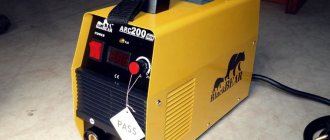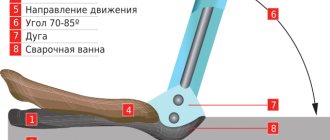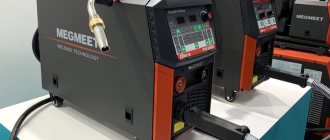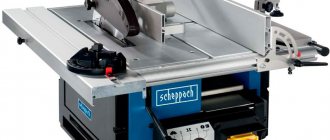There is an opinion that can be considered an axiom for home craftsmen: “Strive to choose the best possible offer.” And if previously the only possible option was a transformer welding machine, which practically did not work at low network voltage, now you have the opportunity to have an unprecedented choice among inverters. They are superior to outdated models in many respects. This includes mobility, light weight, and the ability to carry out welding in field conditions when the network voltage is of very low quality. In this article we present the 16 best welding inverters for home and garden in the price category from 7,000 to 75,000 rubles. All prices are taken from Yandex Market.
Main characteristics of welding inverters:
- Power (rated welding current). This characteristic is indicated in the passport for the device. The rated welding current is the value A at which the inverter (taking into account the recommended load duration, PN%) will operate without shutting down due to overheating. Considering the conditions of the required operation, for example, a rated current of 120A is required, you should choose a device with a rated current of 180A, i.e. Allow a current reserve of about 50%. This will allow you to carry out welding work when the input network voltage is critically reduced and when using cables with a length of over 5 meters.
- Load duration (LO). Characterizes the operation of the welding inverter in intermittent mode.
- Supply voltage range. If the mains voltage has significant deviations from the nominal value, and this often happens outside the city and in holiday villages, then it is considered unstable and you should purchase devices that can operate with voltage surges of 20-30%.
- Additional characteristics that ensure ease of use of the equipment: ARC FORCE (arc force) - arc stabilization;
- HOT START (hot start) - provides simple arc ignition by increasing current loads during start;
- ANTI STICK (anti-stick) - turns off the device in the event of a short circuit, avoiding sticking of the electrode.
Content
- Semi-automatic or inverter: which is better for a beginner
- How to choose a welding machine for a beginner: what to look for
- Our top best welding machines for beginners
You can weld a frame for a canopy, greenhouse or gate, install bars on the windows of a country house, and carry out minor repairs in the garage yourself.
To do this, you need to understand the welding process and select a welding machine. There are models on sale for household, semi-professional and professional purposes with different characteristics, functionality, capabilities and prices. We share tips on which welding machine to choose and buy for a beginner for a summer house or home, based on the upcoming tasks.
Advantages and disadvantages
When buying a welding inverter, you need to consider their advantages and disadvantages . The advantages include:
- Relatively low weight of the device.
- Cost-effective due to high efficiency (up to 90 percent).
- Working with various metals.
- Can be used by inexperienced users.
- Versatility in the use of electrodes.
- Mobility.
The disadvantages include the high cost of both the device itself and its repair, as well as special requirements for humidity and dust.
Semi-automatic or inverter: which is better for a beginner
Some devices are only suitable for working with thin metal, while others are suitable for working with thick metal. Some have high deposition productivity, while others have relatively low ones. There is equipment that is convenient to use outdoors and in hard-to-reach places, and models that are not intended for “fields”. Therefore, when choosing a welding machine for a beginner, it is important to start not from the amount he is willing to spend, but from the purpose of the purchase and operating conditions.
Manual arc welding inverters
Manual or MMA welding with a coated electrode is the most common. The method is simple - the electrode core is melted and transferred to the weld pool. An external supply of shielding gas is not required. It is provided by coating the electrode, which forms gas and slag. They protect the bath from air: oxygen, hydrogen and nitrogen.
Piece electrodes need to be replaced frequently due to their short length. Welding performance is sufficient for everyday tasks and part-time work. There is no need to carry a protective gas cylinder with you. Thanks to this, inverters are convenient when you need to load the device into the trunk and go from the garage to the country house, as well as when you need to weld on the street or in a confined space.
There are dozens of types of electrodes. This allows you to work with different alloys and expands the possibilities. But you need to remember that the electrodes do not burn out entirely - the cinders are thrown away, so their utilization rate is no more than 70% per 1 kg.
Semi-automatic machines for welding in shielding gases
For semi-automatic or MIG welding, you need a spool of wire, a gas cylinder and a torch. The arc and weld pool are protected by the gas in which you work.
Semi-automatic welding is faster and more productive than MMA. Therefore, it is more suitable for garage repairs, starting a small business and making money. This is an appropriate choice when welding work needs to be done quite actively and frequently, and it is possible to transport both the apparatus itself with a spool of wire and a cylinder with hoses to sites.
Welding wire utilization rate up to 90%. There is no need to change it often and constantly throw away leftovers.
There is no point in comparing inverters for MMA and semi-automatic machines for MIG from the point of view of which welding machine is easier for a beginner to weld. To develop any skill you need practice.
An inverter can be recommended for home, garden and minor repair work because of its practicality: mobility, compactness and versatility. If your plans include garage repairs and earning money, it’s better to choose a semi-automatic.
Types of welding
Different industries require a combination of different types of metal . There are several ways to connect them together. For some, any will do, while others cannot be welded without using a special technique.
Manual arc method
The method appeared earlier than others and is the main method of joining metals. It is used both in large industries and in private workshops. It is based on the occurrence of an electric arc between the metal and the electrode, melting the surface. The method is applicable both outdoors and indoors.
This method has other advantages:
- It is cheap.
- Does not require cleaning from rust and dirt.
- Suitable for working with thick metal.
- Does not require additional equipment.
However, this method is quite difficult to master. It also has other disadvantages:
- The minimum thickness limit is 1.2 millimeters. Thinner metal is burned through.
- High consumption of electrodes.
- It is necessary to remove the slag from the seam.
- Welding marks in the form of spatter remain on the surface.
Method of working in a gas environment
This method of semi-automatic welding in the specialized literature is designated by the abbreviation MIG. Instead of electrodes, wire is used, which is fed from a reel at a certain pace to the welding site, which is protected by argon or carbon dioxide. There is virtually no slag formation at the connection point. You can work with metal of different thicknesses.
The method is easy to learn and can be used to join both thin and thick metal sheets. In addition, aluminum and stainless steel with a thickness of 0.6 millimeters or more can be welded. The method is quickly mastered and widely used in various industries.
A separate welding method using special flux-cored wire does not require any protection.
Electric welding with tungsten electrodes
This method requires the presence of an inert gas and is referred to as TIG. In this case, formation occurs from a non-consumable tungsten special electrode to the metal surface. In this case, a plasma column is formed. A special metal is used to fill the seam. This method is also called plasma.
Welding can also be done without filler. This is an argon welding method.
Using this method, you can weld all kinds of steel, copper, aluminum, magnesium and copper alloys.
In addition to being the slowest welding method, it is also the most difficult to learn.
How to choose a welding machine for a beginner: what to look for
The selection algorithm is simple - first you decide on the main technical parameters, then on additional functions. A beginner should choose which welding machine to buy in exactly this order. At the first stage, you select a number of models that correspond to the purpose of the purchase; at the second, you weed out those that do not have the functions you need or, conversely, have unnecessary options.
Main parameters
Main characteristics - maximum welding current and electrode diameter, power consumption, mains voltage, operating time.
Maximum welding current
It depends on what thickness of metal you can weld and what diameter electrodes you will use. For example, if you plan to work with pipes or profiles up to 5 mm thick, then an inverter with a maximum output current of 160 A will be sufficient. There is no point in buying a device with higher performance if you will not weld thicker workpieces.
When choosing, you can refer to our table:
| Metal | Electrode diameter, mm | Workpiece thickness, mm | Maximum current, A |
| Carbon/stainless steel | 1,6-2,5 | up to 4 | 145 |
| 1,6-3,2 | up to 5 | 160 | |
| 1,6-4 | to 10 | 200 | |
| 1,6-5 | up to 15 | 250 | |
| 1,6-6 | up to 24 | 300 |
Power consumption
When assessing power consumption, you need to take into account the network capabilities at your dacha or garage. Currently, 15 kW is allocated to summer cottages. This is enough to work with an inverter up to 200 A, even if other equipment is turned on in the house. In older dachas and garages, the network can be designed for a lower load.
When buying a device, it is better to give preference to a model with a current and power reserve of about 20-30%. This will give you a little more options and allow you to solve non-standard problems if the need arises.
Mains voltage
According to technical conditions, one or three phases can be allocated for the electrification of a site or garage. Depending on the model, welding machines can operate from a single-phase or three-phase network. There are inverters with a built-in automatic transformer that operate at any voltage. But their price is higher, and they are needed for professional use and travel.
As a rule, welders for household and semi-professional needs with an operating current of up to 250 A are connected to 220 V networks. If your network offers 380 V, then you can choose a device with a higher welding current.
Single-phase networks in dachas and garages are characterized by voltage sags. So that you can work in such conditions, it is better to buy an inverter, the characteristics of which indicate the ability to weld at 130-160 V. Otherwise, you will need a stabilizer. As well as for semi-automatic devices that do not like voltage dips.
Duration of continuous operation
The PV or PN indicator shows how long the device will work and rest. For example, for a given time period of 10 minutes, a model with a duty cycle of 60% in the maximum welding current mode works for 6 minutes and rests for 4 minutes. At low currents, welding can be performed for as long as necessary - 100% duty cycle.
Additional functions
To make the devices easier and more convenient to use, they are equipped with additional functions. In practice, not all may be needed. For a beginner in MMA the following may be useful:
- Hot start. Helps ignite the arc at the beginning of welding, especially useful when working with rusty metal, raw electrodes and electrodes with a basic coating, and eliminates the need to tap the ignition tip for a long time.
- Antistick. Reduces the current to minimum values when the electrode sticks and avoids its overheating, makes it easier to weld thin-walled metal and work in general - electrodes periodically stick even for experienced welders, and tearing them off is time-consuming and difficult.
- Adjustable arc force. Maintains stable combustion, needed if you do not have the skill to hold an arc and when welding at low currents - when the arc begins to die out, the working current increases automatically.
Additional useful functionality of semi-automatic devices includes inductance adjustment. It allows you to change the characteristics of the arc - make it more rigid for positional welding and deep penetration and softer with less spatter for face welds. The function of annealing the wire is also useful, ensuring its constant ejection after each cycle - this is convenient for the next start.
Modern machines may feature synergetic control for intelligent welding. You only need to set the diameter of the electrode or the thickness of the metal and the device itself optimizes the parameters and functions.
Welding rectifier
To form a stable arc, reduce the number of electrodes used in operation, and reduce splashes, the devices use rectified pulse current. As a result, it is possible to obtain a thin seam at the joint. This is important for parts used for decorative purposes.
Such equipment involves the use of alternating single- or three-phase current with a bridge circuit. Working on three phases involves increasing power, but is not always possible.
When choosing this welding method, you need to take into account stepwise power control and the maximum thickness of the electrodes.
Our top best welding machines for beginners
We can recommend several devices that are suitable for beginners. The characteristics and functionality of the models allow you to choose them for your home, cottage and garage.
The best inverter welding machines for a beginner
Svarog REAL ARC 200 BLACK with a welding current of 200 A for MMA is a good choice for beginners choosing an inverter for country tasks. The device is good for household use and allows you to work with electrodes up to 4 mm thick. This is enough for welding fences, gates, gates and canopies, including thick-walled pipes made of different types of steel. The device cooks stably at drops of up to 160 V and is equipped with an anti-stick function.
Slightly more expensive Svarog REALSMART ARC 200 is an inverter with synergetic control and a convenient digital panel. It offers anti-stick functions, hot start for easy ignition and arc force for improved welding performance. When choosing the electrode diameter, the welding current and the afterburner and hot start functions are adjusted automatically. The device is suitable for welding with electrodes up to 4 mm and working with steel up to 10 cm thick.
The best semi-automatic machines for beginners
The compact semi-automatic Aurora POLO 160 is a practical solution for beginners who plan to engage in MIG welding and work with wire up to 0.8 mm. The analog control panel allows the operator to easily set the thickness of the material being welded, after which the machine automatically sets the optimal current and voltage values. The model is lightweight and weighs only 8.6 kg, equipped with afterburning and inductance adjustment functions.
The polarity is easily changed, which makes it possible to use a self-shielding wire and eliminate the need to carry a gas cylinder, so the device is truly portable.
For those who want to purchase a device with advanced capabilities for a garage, country workshop and part-time work, we recommend AuroraPRO SPEEDWAY 180 SYNERGIC. This is a universal semi-professional semi-automatic machine, with which you can work with solid and flux-cored wire up to 1 mm, as well as piece electrodes up to 3 mm thick in MMA mode.
For MIG welding, inductance settings for adjusting arc characteristics and constant wire annealing are available. For MMA, a full set of useful functions - anti-sticking, arc force and hot start. The control is synergetic - this simplifies setup.
Home inverter
To connect such a device, both a stationary power source and a portable transformer are used. As a result, the operating voltage decreases to 30 volts, and the currents increase to several hundred amperes, which is enough for an arc to appear and the melting of metal surfaces to begin.
Compact devices have a hot start. This means that welding is possible immediately after switching on. The temperature at the end of the electrode is very high. The result of this was the formation of a thin, high-quality weld.
Such equipment allows the use of various types of electrodes. There is also a draw feed slot for semi-automatic operation. To do this, you need to use a cylinder with inert or carbon dioxide. Thus, such a device allows you to weld both simple metals of various thicknesses, as well as stainless steel, copper and aluminum alloys.
Additional characteristics to consider when choosing welding equipment
- Power consumption . This parameter is measured in kW (kilowatts) and shows the maximum power with which a particular welding equipment can operate. The higher this indicator, the greater the current provided, which allows you to cook even thick metal.
- Open circuit voltage. This characteristic of welding equipment is an indicator of the voltage output to the electrodes. The value ranges from 40–90 V and depends on the type of machine, type of welding and the electrodes themselves.
- Minimum welding current. We are talking about the lowest current value that allows the formation of a weld. This parameter indicates whether the device can be used when processing thin metal that is destroyed by excess current.
- Maximum welding current. This characteristic of welding equipment allows you to understand whether the technique is suitable for joining elements made of thick metals using large-diameter electrodes. You can check the dependence of material thickness on welding current in the corresponding tables.
- Minimum electrode diameter. This indicator sets the minimum electrode size for a specific device.
- Maximum electrode diameter. This option is the opposite of the previous one. You need to understand that the thickness of the electrodes is selected based on the intended type of welding, characteristics of the metal, etc.
The field of welding equipment production is constantly evolving, and new technologies are appearing. It is important that modern devices are subject to high quality requirements, and compliance with all standards is monitored by the authorized bodies of Rosgostekhnadzor.
What is manual MMA arc welding
Manual arc welding is called so because the process of igniting the electrode and maintaining the arc to form a seam is performed entirely manually. The electric arc was discovered a long time ago, but was first used to join metals in 1882. In 1907, the process was improved by coating electrodes and received the international designation Manual Metal Arc (MMA).
The essence of the manual arc welding process is to connect the current source to the network. There are two wires coming from the device (+ and -). One is attached to the product, and the second is equipped with an electrode holder. An electrode is inserted into it - a metal rod with a diameter of 1.6 to 6 mm, covered with coating. Tapping on the surface closes the circuit and initiates an electric arc.
The arc temperature is 5000 degrees, therefore, due to thermal energy, the edges of the metal being connected and the rod of the electrode itself melt. The molten metal is called a weld pool. To protect it from exposure to ambient air, a gas cloud is needed. This role is played by the electrode coating, which melts and creates a protective environment. Thanks to this, the metal hardens without pores. After crystallization, a slag crust forms on the surface of the seam, which is removed by lightly tapping with a hammer.
If you swap the wires (connect the minus to the product and the plus to the holder), you will get reverse polarity. In this case, the current will move from the product to the electrode, which reduces heat input and is in demand when welding thin products. With direct polarity (plus to the ground, and minus to the holder), the voltage moves from the electrode to the workpiece, which accelerates the melting of the edges and increases the welding speed.
To control the process visually, the welder must wear a protective mask with a light filter. It prevents damage to the retina by UV and IR rays, protects against bright light and prevents flying scale from reaching the face. Mandatory personal protective equipment is leggings, thick clothing and boots. There must be a headdress without a visor.
Detailed video lesson about manual arc welding
Choosing an inverter for home and part-time work
For the last twenty years, inverters have occupied the podium of welding equipment for home craftsmen. Unlike bulky transformer “welders”, inverters can be freely carried on the shoulder and transported anywhere on a construction site. Some models allow you to repair a car by spot welding, others have an argon-arc function for connecting two parts without an electrode wire. There are also semi-automatic machines for serious installation work. Which inverter should I buy? Let's look at the selection criteria "at a glance".
Operating principle and advantages of the inverter device
Such devices are equipped with inverter control circuits that increase the frequency of the current transmitted from the electrical network from 50 Hz (the frequency of the alternating current network) to several thousand hertz. Then the high frequency current is supplied to the winding of the step-down transformer. Thanks to this, the inverter “welder” is superior to the transformer one in the following indicators:
- More stable arc and smooth seam . During operation, the arc does not “jump” even when the voltage drops in the network, and as a result, a more even seam is produced.
- Light weight . Increasing the frequency made it possible to reduce the size of the transformer coils, which significantly reduced the overall weight of the unit. For example, an inverter model can weigh 3 - 4 kg, while a transformer model with the same performance indicators can weigh as much as 20 kg.
What is the maximum current needed?
When you decide which welding inverter is best to choose, pay attention to the maximum output current. In many ways, the choice of device for this indicator depends on how thick the metal you plan to weld and what electrodes you will use. For example, for welding metal products with a thickness of 2 - 3 mm, electrodes (for manual arc) with a thickness of 3 - 4 mm are used. To perform such work, you will need a device with an operating current of at least 120 A. Note that in the household it is rarely necessary to weld very thin parts (less than 1 mm), so 120 A is the working minimum for a home craftsman.
Metal with a thickness of more than 5 mm will take a device with a current load of 200 A. Please note that machines with argon-arc welding have a maximum current of 120 A and higher, and semi-automatic inverters start at 220 A.











